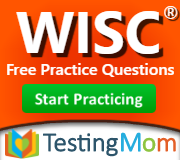The Wechsler Intelligence Scale for Children (WISC) Test Guide
| WISC Summary
|
|
|---|---|
| What: Wechsler Intelligence Scale for Children | |
| Who: Children ages 6 - 16 can take the test. | |
| Where: Tests are administered in schools and doctor's offices. | |
| When: This test can be issued at anytime. | |
| How: The test is a verbal test and does not involve reading or writing. | |
| Type: Verbal | |
| Why: The test is used to assess intelligence, giftedness, ADHD and learning disabilities. | |
| Time: Varies | |
| Language: This is a non-verbal test. | |
| Preparation: Students can use test preparation workbooks and other materials to get ready for this exam. | |
| Cost: Varies widely. | |
The Wechsler Intelligence Scale for Children, or WISC, is a verbal exam for children ages 6 to 17 that assesses a child’s intelligence and generates an IQ score. The exam was developed by David Wechsler and may be used as an admissions test for some private schools, or as an exam for entrance into a gifted program. The exam may also be used to help diagnose learning disabilities, ADHD and mental retardation.
Test takers are given an IQ, or full-scale, score following the exam, as well as four composite scores: Processing Speed, Working Memory, Verbal Comprehension and Perceptual Reasoning.
The exam’s subtests include:
- Arithmetic – This section evaluates the child’s ability to reason with numbers.
- Block Design – In this subtest, a child’s analyzation and synthesis of design skills are measured.
- Cancellation – This section assesses the child’s attention, processing speed and visual neglect.
- Coding – This subtest examines a child’s dexterity, nonverbal learning and nonverbal memory.
- Comprehension – Here, the child’s social, moral and practical comprehension skills are evaluated.
- Digit Span – This section assesses a child’s attention and short-term memory.
- Information – This section asks children to recall information taught in school, including basic facts and cultural knowledge.
- Letter-Number Sequencing – This subtest evaluates a child’s sequencing abilities, processing speed, short-term memory and attention span.
- Matrix Reasoning – This section measure’s a child’s spatial and abstract perception and visual processing.
- Perceptual Reasoning Index – In this subtest, a child’s ability to organize and perceive visual materials is evaluated.
- Picture Completion – This section asks students to identify missing parts in objects and helps to evaluate recognition and attention to detail.
- Similarities – Here, a child’s logical thinking, verbal abstract reasoning and verbal concept formation are evaluated.
- Symbol Search – This subtest measures a child’s perception and recognition abilities.
- Vocabulary – In this test, children’s knowledge of vocabulary, concept formation, word usage and fluency are evaluated.
- Word Reasoning – This section measures a child’s verbal concept formation, categorical thinking, verbal abstract reasoning and analogical thinking skills.
While most exams are administered by a child or school psychologist, teacher or other trained professional, exam kits are available for purchase through PsychCorp and range from $1,049 to more than $1,700.
To find test preparation materials for the WISC, visit our WISC Directory. For more on the WISC and similar assessment tests, read our interview with test expert Tim Sitar.
Sources: Critical Thinking, PsychCorp





